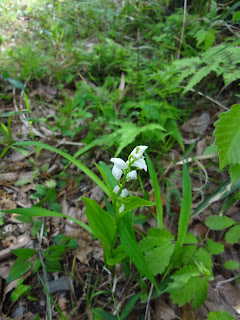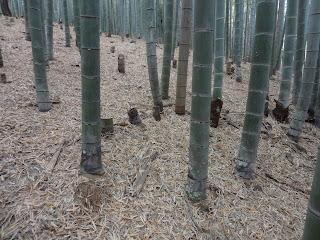 |
| Cephalanthera erecta in Niiharu Citizen Forest 新治市民の森 |
Spring delicacy for Japanese cuisine is bamboo shoots. Harvesting bamboo shoots is tiresome but necessary task to manage healthy bamboo forest. If we skip it, bamboos sprout here and there too tightly. A forest becomes unpassable for humans because of too congested bamboos. The forest could die soon compared with managed bamboos. We can find such example along Keikyu Line 京急, near Jin’muji Station 神武寺駅. There, the bamboo forest is in Ikego Housing Detachment of the US Navy. I guess (1) Americans don’t know how to manage bamboo forest and/or (2) the area is off-limit due to not-yet decommissioned explosives left by Japanese Imperial Navy. Anyway, we can see “packed” bamboos along the wired fence running by the railroad. I think Keikyu does a formidable job to keep their train track usable with ferociously encroaching bamboos roots. The journey along the area could be lined with browned bamboos sooner or later. In contrast, if we manage the density properly, we can maintain bamboo forest for generations. Harvesting bamboo shoots is one of the most important tasks for this purpose. It must be done in a brief period of spring, a month or so. We Lovers for Niiharu Citizen Forest 新治市民の森愛護会 do this every year. Of course, doing this needs permit from landlords (otherwise, it’s a criminal offence, i.e. theft). It’s a kind of reward for Niiharu Lovers after our year-round maintenance activities for bamboo forests.
As Niiharu Lovers do our forestry weekends, we often could not finish digging out bamboo shoots during this narrow window of a year. Bamboo shoots can become young bamboos in a matter of a day or two. If it happens, we have to thin them by kicking down, provided you have enough muscle power for your legs. Else, we must use our handsaw. That’s another wearisome undertaking. There is a talk among Lovers to buy chainsaws for bamboos (; they have a different spec), but we need money … Worse, young bamboos are not edible. Er, it might be possible to use them as materials for handcrafts, but it takes time and effort to create such things. Besides, the amount of bamboo “timber,” young and old, we have from thinning the forests is too much to consume in a year. In the end, we have to drag out those stroke-down bamboos from hilly forests of Niiharu and to ask the City collecting them as garbage. Waste! That’s the standard for Niiharu every year … Luckily or not, this year it is not.
Last winter was very dry at least in Kanto region of Japan. In Yokohama, official meteorological stats says this;
<Rainfalls in Yokohama, in
mm, data from Japan Meteorological Agency>
|
|
1981-2010 Average
|
2018-19
|
|
November
|
107
|
56
|
|
December
|
54.8
|
70
|
|
January
|
58.9
|
14.5
|
|
February
|
67.5
|
48.5
|
|
March
|
140.7
|
101
|
 |
| Very dry winter for Niiharu |
I suspect that’s one of the reasons why we have a “Back Year” for bamboo shoots. In past 3 years, Niiharu Lovers had to start digging out bamboo shoots during the last week of March, and we continued to do so till the first week of May. This year, no. In March no shoot was found in bamboo forests of Niiharu. Frankly, we were disappointed. “We have to wait for spring dishes a bit more this year …” So we waited, waited, and waited. In the fourth week of April, we finally encountered tiny tips of bamboo shoots poking out from the forest floor. It’s almost a month later, compared with normal years. “Wow, finally! Let’s dig!”
 |
| Cephalanthera falcate is regulars for bamboo forests in Niiharu. |
In ordinary years, as we could not catch up with the growth of shoots, we often dig them while their tips are already at 20 or 30cm above the ground. This year, we literally had to dig out the entire body of shoots. As a rule of thumb, if we can harvest bamboo shoots while they almost stay underground, they are the softest. Ho ho ho ho ho 😁 … Another principle is, the fresher the bamboo shoots, the tastier, just like summer cones. So, we brought them back home ASAP, in haste peeled the shoots and boiled them with rice bran within 3 hours after digging. The result was “Oh, Naomi, this year’s bamboo shoots are very soft and tasty! Well done!” So my mum said. Everything comes to those who wait. 😌
 |
| Could
you find a tip of bamboo shoot in this photo? It’s in One O’clock from the center … |
 |
| I did a bit of digging … |
 |
| Done! |
 |
| Phew! |
 |
| Tiny, tiny, tiny … |
But, the shoots are really really small this year. I’m checking prices and sizes of bamboo shoots in supermarkets. Sure enough, they are comparatively shorter, and their price has not gone down even when it is supposed to be a peak period. Moreover, in Yokohama this year, not many areas of production are shown in store shelves for bamboo shoots. They started to come in the final week of March from Kyushu 九州, the southern-most island of Japan. As of early May, this is as yet almost an exclusive area for this year’s bamboo shoots sold in Yokohama. That’s strange. We’re in metropolitan area of Tokyo, you know. My seniors of Niiharu Lovers concluded, “This is definitely a Back Year.” “Yes. Well, this is how nature goes. (Philosophical nods around.)” Hmmmmmm. Before, I was not much sensitive to yearly fluctuation of qualities for veggies. In the end, we can buy tomato while it’s snowing outside skyscrapers. Now, I’m entering neighborhood forests weekly, and amazed to experience infinite variety of nature … or to be exact for the matter, to know a Back Year for bamboo shoots. I think it’s a kind of progress for me. Yeah.
 |
| A scene in a supermarket |
 |
| We definitely need to work more here … |
If you find an environmental issues
in Kanagawa Prefecture, please make a contact with Kanagawa Natural Environment Conservation Center 神奈川県自然環境保全センター
657 Nanasawa, Atsugi City, 243-0121 〒243-0121 厚木市七沢657
Phone: 046-248-0323


No comments:
Post a Comment